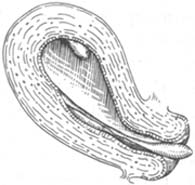| disease | Endometrial Polyp |
| alias | Endometrial Polyp |
Any mass attached to the inner wall of the uterine cavity via a slender stalk can clinically be referred to as a uterine polyp. Therefore, polypoid masses within the uterine cavity may include pedunculated submucosal fibroids, endometrial polyps, adenomyomatous polyps, and malignant polyps (carcinoma or sarcoma).
bubble_chart Etiology
The causes of polyp formation may be related to inflammation, endocrine disorders, particularly excessive estrogen levels. Most scholars believe that polyps originate from immature uterine membranes, especially the basal membrane.
bubble_chart Pathological Changes
Upon gross observation, the most common type is a localized endometrial mass protruding into the uterine cavity, either solitary or multiple, grayish-red in color, and glossy. Generally small in size, the average diameter ranges between 0.5 to 2 cm. The smallest may measure only 1–2 mm in diameter, while larger and multiple polyps can fill the uterine cavity. The stalks vary in thickness and length, with longer ones potentially protruding beyond the cervical os. Some have shorter stalks and exhibit diffuse growth (Figure 1). The surface of the polyp often shows hemorrhage and necrosis and may also be complicated by infection. If the stalk undergoes torsion, hemorrhagic infarction may occur.

Figure 1 Uterine endometrial polyp
Microscopic examination: Uterine endometrial polyps are composed of endometrial tissue, with their surface covered by a layer of cuboidal or low columnar epithelium. The central portion of the polyp forms a fibrous longitudinal axis containing blood vessels.
Due to the narrow stalk and reduced blood supply, the polyp is highly prone to degeneration. The most common occurrence is thrombosis within the polyp’s vessels, turning it deep purple due to static blood. Necrosis often begins at the apex and may eventually lead to sloughing.
The pathological diagnostic criteria for malignant transformation of a polyp are: ① The entire morphology of the polyp must be observed; ② Malignant changes are confined to the polyp; ③ The surrounding endometrium shows no evidence of carcinoma. Care should be taken to differentiate it from polypoid growth of endometrial adenocarcinoma.bubble_chart Clinical Manifestations
This disease can occur at any age after puberty but is commonly seen in women over 35. Small, solitary endometrial polyps within the uterus often have no clinical symptoms and are usually discovered incidentally during gross examination after hysterectomy for other conditions or diagnosed after diagnostic curettage. Multiple or diffuse types often present with hypermenorrhea and prolonged menstruation, which are related to increased endometrial surface area and endometrial hyperplasia. Large polyps or those protruding into the cervical canal are prone to secondary infection and necrosis, leading to irregular bleeding and foul-smelling bloody discharge.
The main symptoms include increased menstrual flow or irregular uterine bleeding; polyps can be seen or palpated at the cervical os, with slight uterine enlargement. Hysteroscopy or fractional curettage can be performed, and the extracted tissue or removed polyps can be sent for pathological examination to confirm the diagnosis. This can also differentiate it from dysfunctional uterine bleeding, submucous uterine fibroids, and endometrial carcinoma.
bubble_chart Treatment Measures
Dilate the cervix, remove the polyp, and then scrape the entire uterine cavity to remove diffuse small polyps, which should be sent for pathological examination. Postoperative follow-up should be conducted regularly to monitor for recurrence and malignant transformation, with prompt treatment if needed. In recent years, some have successfully used hysteroscopic surgical resection or laser therapy for small polyps.





